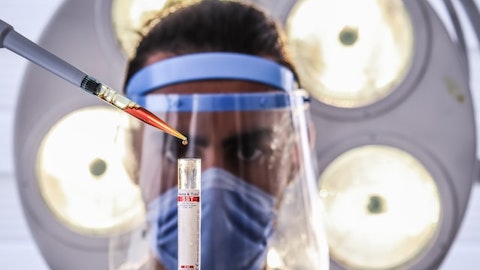And that’s important because as you said, we think about levels oftentimes with the protein in the in vivo studies like the fold increase off of baseline is the best way to start thinking about translational potential. And as we think about being able to increase the fold based on results, 7-fold from baseline. If we went back and looked at human studies, in the range of, I think, it’s like 2.5 to 3-fold to 5-fold improvement that ultimately translate from these ZZ patients to MZ. So, it’s not just a measurement of the protein that’s being produced in the rodent model, but ultimately, in the translation of how much the fold of editing is translating to full protein production, that’s giving us our confidence as we move in the clinic. So like anything else, we do need to run that first study.
I think, we picked the right program with the right delivery tool to demonstrate first-in-class editing. But really excited as we go into September to talk about a multitude of opportunities beyond the AATD, beyond just protein correction, beyond the liver, that we’re very excited to share with everyone, and it will be a great opportunity to talk about the future of RNA editing.
Eun Yang: Great. Can I have a follow-up question. So you have about $225 million in development milestones from GSK on this AATD program. So starting Phase 1/2 this year, how much of a milestone would you be expecting from that?
Paul Bolno: Great question, Eun, in terms of — as we alluded to before, that we’ve got a number of development milestones beyond commercial milestones from GSK that come in over time. What we can do, obviously, is break out those payments at various points. Obviously, as we receive them, there are opportunities where those are disposed, obviously, in our financial statements. But the key is delivering this program into the clinic and beyond, which contributes milestone payments. Importantly, beyond AATD, and I think that was another important feature is, there are a whole host of programs that are moving collectively with GSK beyond AATD. And it’s important to note, not only do we have those programs where GSK pays 100% of the R&D expenses as we’re advancing them.
But those also have milestones, both preclinical and clinical and commercial milestones. So, as we think about the magnitude across the collaboration, there are multiple potential inflows coming from execution. And I think it’s important, as you said, that those are not counted in our runway statement. So those would be accretive to our current cash position.
Operator: Our next call comes from the line of Asim Rana of Truist Securities.
Unidentified Analyst: Good morning. This is Osman for Joon. My first question is, given that you’ve improved upon RNase mediated degradation, splice blocking ASOs, RNAi, RNA editing, all with your AMR platform. I’m just wondering if you have any plan to design guide RNAs with enhanced properties like stability and low off-target cutting, basically to improve upon the high-rate DNA/RNA guide similar to those being used by Caribou. And as a follow-up question, just wondering, maybe could you comment on the potential to use patients who’ve already received microdystrophin gene therapy from a competitor for your N531 program, and I’m specifically referring to Sarepta’s program.
Paul Bolno: Thank you. I mean, I think if we take the first question, as you pointed out, and I think it parallels Eun’s question earlier, which is we have made a substantial investment in building what we would view as best-in-class kind strength. We think about all of these opportunities and you elegantly laid them out, all of them involve kind of this mechanism with RNA protein interaction, right? It’s all about a guide RNA interacting with a protein and exerting a biological obnoxious effect, whether that’s cutting via RNAse H4 [ ao2 ], whether that’s exercising and utilizing the splicing machinery to generate and up protein correction or generate protein or RNA editing using ADAR. I think the opportunity set that’s in front of us are a multitude.
I think we’re going to be focused on portfolio construction and translation right now with this toolbox into meaningful medicine. However, as you’ve known in our history, we’ve always had through various collaborations and internal research exercises collaborations that have pushed us into new areas. So whether that’s editing beyond data eye, whether or not that’s editing, including, as you said, highly specific editing around other mechanisms, whether its DNA, but that’s not our core capability. There are always opportunities that we have in being approached too by others and saying, what is the opportunity set that our proprietary chemistry can bring to other modalities. So, we’re not close minded to say, this is all we do. We recognize that you can’t always predict what’s coming behind.



